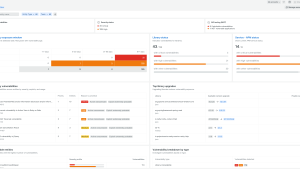In today's digital landscape, the role of software and applications in driving business value and engagement is undeniable. As the proliferation of these digital touchpoints continues, the need for their security is more urgent than ever. Let's dive deep into the essence of application security, exploring the importance of a robust policy, its crucial components, and how New Relic interactive application security testing (IAST) can transform your application security journey.
What is an application security policy?
An application security policy, at its core, is a collection of directives and practices designed to govern how application security is maintained within an enterprise. This policy is pivotal in assuring that applications are protected from inception, through development, deployment, and throughout their lifecycle. It seeks to safeguard data, prevent breaches, and ensure an uninterrupted user experience.
Five necessary elements of an application security policy
A resilient application security policy begins with understanding its foundational pillars. Dive into these five indispensable elements that shape a sound policy.
- Scope and objectives: Start with a clear definition of what the policy covers and its primary goals. This foundation offers a strategic direction to mitigate specific threats and vulnerabilities.
- Roles and responsibilities: Designate clear roles related to application security, ensuring there's clarity in who does what and who's accountable.
- Standards and procedures: Specify the security standards and processes in place. This can encompass everything from encryption standards to authentication mechanisms.
- Incident response plan: Outline the action plan for any detected security issue. This should cover everything from identification to recovery post-incident.
- Review and updates: Regularly revisit and update the policy, ensuring it adapts to changing threats and organizational shifts.
How to create and implement an application security policy
Building a secure application security policy isn't just about listing rules; it's a meticulous endeavor, demanding collaboration and alignment with broader organizational objectives. After crafting the policy, the real test is in its company-wide deployment. The following steps will guide you through the creation and effective implementation of your policy.
Creating an application security policy
Creating a robust application security policy requires a fusion of expertise, insights, and strategic planning. Let's navigate the process of formulating a policy tailored to your organization's unique landscape.
- Engage stakeholders: Foster communication with IT professionals, developers, and business leaders to gather insights.
- Conduct a risk assessment: Evaluate your current security stance, identifying possible vulnerabilities and potential threats.
- Draft the policy: Use the previously mentioned elements as a template to create a policy suited to your organization's unique needs.
- Review and refine: Before the final sign-off, review the draft with all stakeholders to ensure it's comprehensive and in line with your business goals.
Implementing your application security policy
Once your application security policy is inked, the journey shifts to ensuring its seamless integration across the organization. Delve into the steps that guarantee effective deployment and adherence.
- Educate and train: Facilitate training sessions to familiarize your team with the policy details and their respective roles.
- Integrate into SDLC: Embed security measures into every step of your software development lifecycle.
- Employ application security monitoring tools: Harness the power of security tools to swiftly identify and address vulnerabilities.
- Regular audits: Periodically assess the effectiveness of your policy, making adjustments based on evolving threats and business needs.

Application security standards
Aligning with recognized security standards is invaluable when crafting your application security policy. Embracing these standards not only strengthens your security stature but also inspires trust amongst stakeholders and clients. Here are some standards to consider:
- OWASP Top Ten: A consensus-driven guideline spotlighting the top web application security threats. An excellent foundation to shield your applications.
- ISO/IEC 27001: A global benchmark outlining best practices for information security management.
- PCI DSS: Essential for applications handling credit card processes, the Payment Card Industry Data Security Standard provides a fortified transaction environment.
- NIST Cybersecurity Framework: Developed by the National Institute of Standards and Technology, it offers guidelines for organizations to adeptly tackle cybersecurity risks.
Enhance application security with New Relic
As pioneers in application performance monitoring, New Relic now offers an unparalleled interactive application security testing (IAST) capability. New Relic IAST is designed to constantly identify, address, and verify critical vulnerabilities, empowering DevOps teams to produce secure code swiftly and confidently.
In conclusion, a well-crafted application security policy is a linchpin in today's digital arena. With tools like New Relic IAST, companies are primed to place application security at the forefront of their digital strategies.
Next steps
Learn more about New Relic IAST.
Sign up for a free account today to take advantage of IAST and the 30+ other capabilities of the New Relic platform. Your free account offers 100 GB/month of data ingest, one full-platform user who can use all of our tools, and unlimited basic users who can view your data and insights.
The views expressed on this blog are those of the author and do not necessarily reflect the views of New Relic. Any solutions offered by the author are environment-specific and not part of the commercial solutions or support offered by New Relic. Please join us exclusively at the Explorers Hub (discuss.newrelic.com) for questions and support related to this blog post. This blog may contain links to content on third-party sites. By providing such links, New Relic does not adopt, guarantee, approve or endorse the information, views or products available on such sites.



